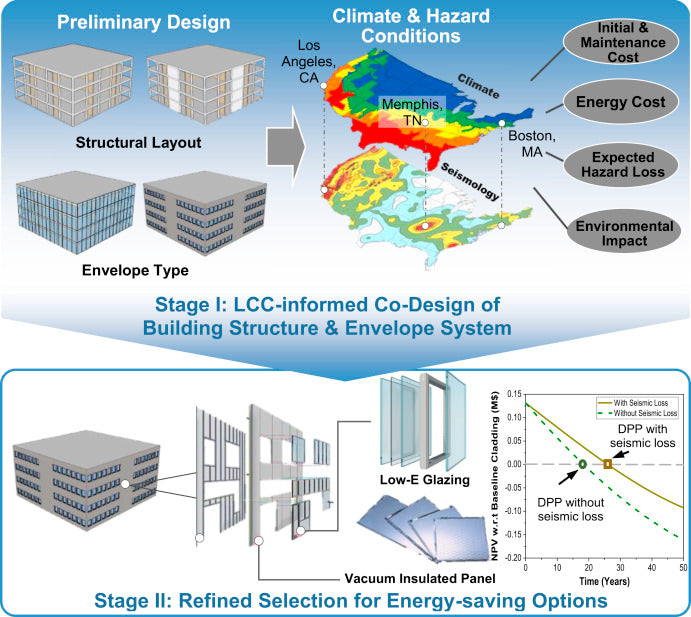In the ever-evolving world of architecture and construction, energy-efficient building envelopes have emerged as a central aspect of modern building design. These innovative solutions not only redefine the aesthetics of buildings, but also significantly contribute to reduced energy consumption, lower electricity bills and a greener environment.
Energy efficiency is at the forefront of modern design and construction practices. The focus on building envelope energy efficiency has never been more important, as buildings are responsible for a significant portion of global energy consumption and greenhouse gas emissions. In this article, we will explore the concept of energy-efficient building envelopes and examine the principles, materials and technologies that make them a game-changer in the construction industry.
What is a building envelope?
The building envelope is a fundamental part of every building and serves as the exterior cladding. It consists of walls, roof, windows and doors and together they form a boundary between the air-conditioned interior and the exterior environment.
The main purpose of the building envelope is to protect residents from the elements while maintaining a comfortable indoor climate.
An energy-efficient building envelope fulfills even more than this basic function. It consists of high-performance materials and design strategies to minimize heat transfer, air ingress and moisture penetration.
Achieving energy efficiency requires a holistic approach that takes insulation, airtightness and thermal bridging into account.
Benefits of energy efficiency
Lower energy costs
The benefits of an energy-efficient building envelope go beyond simple energy savings. By reducing heat transfer into and out of the building, these envelopes help to significantly reduce energy costs. In well-insulated buildings with adequate airtightness, heating and cooling costs can be reduced by up to 20-30%.
Reduced carbon footprint
The impact of energy efficiency on the environment is significant. If we reduce energy consumption, we can achieve a smaller carbon footprint. By reducing the energy required for heating, cooling and lighting, energy-efficient building envelopes play a critical role in mitigating climate change and reducing a building's overall environmental impact.


Image source: Internet
Design principles
When designing an energy-efficient building envelope, several principles must be carefully considered. Some important aspects are discussed here and the principles are not limited to the considerations mentioned here.
Proper insulation
Effective insulation is crucial to prevent heat transfer. High-quality insulation materials such as spray foam, fiberglass and cellulose are strategically placed within the envelope to minimize heat loss in the winter and heat gain in the summer.
air tension
An airtight building envelope minimizes the entry of outside air. This reduces the need for continuous heating or cooling, resulting in energy savings and greater comfort for residents.
guidance
The orientation of a building in relation to the sun and prevailing winds is crucial. An energy-efficient design uses natural resources for heating and cooling and optimizes the use of natural light and passive solar heating.
Materials and technologies
The quest for energy efficiency has driven innovation in construction materials and technologies. Some of the materials and technologies are as follows.
High-Performance Windows: Energy-efficient windows are designed to reduce heat transfer while still letting in natural light. Double or triple glazing and low-e coatings are common features.
Smart insulating materials: New insulating materials such as airgel and phase change materials offer better thermal performance. These materials adapt to temperature changes and thus optimize energy consumption.
Green Roofs and Walls: Green roofs and walls are environmentally friendly options that improve insulation, reduce stormwater runoff and increase a building's aesthetic appeal.
Regulations and certifications
Building regulations
Energy efficiency regulations and building codes are constantly evolving to meet environmental goals. These regulations establish minimum standards for insulation, airtightness and general building performance. Compliance with local building codes is essential to ensure your building envelope meets these standards.
Energy efficiency certifications
Certifications such as Leadership in Energy and Environmental Design (LEED) and ENERGY STAR provide a standardized method for evaluating and recognizing energy-efficient buildings. Obtaining these certifications demonstrates your commitment to sustainability and energy efficiency. To obtain these certifications, you must meet certain criteria related to the performance and design of the building envelope.
By delving deeper into these sections, you will gain a more comprehensive understanding of energy-efficient building envelopes, their benefits, construction principles, materials and technologies, and the importance of complying with regulations and certifications to achieve energy efficiency.
In short, energy-efficient building envelopes represent a transformative approach to modern architecture. By reducing energy consumption, reducing costs and promoting sustainability, they are an essential part of our journey towards a greener and more energy-conscious future.
Common questions
Q1: What role does insulation play in an energy-efficient building envelope?
A1: Insulation is essential to maintain a stable temperature in the building. Helps reduce heat loss in winter and heat gain in summer.
Q2: Are energy-efficient building envelopes only suitable for new buildings?
A2: Although energy-efficient building envelopes are often integrated into new buildings, they can also be retrofitted into existing buildings to improve their energy efficiency.
Q3: How can I find contractors with experience in energy-efficient construction?
A3: Look for contractors with experience in green building methods and who have certifications in energy-efficient construction.
Q4: Do energy-efficient building envelopes require special maintenance?
A4: They may require special maintenance, such as: B. regular checks for tightness and insulation effectiveness, but general maintenance requirements are generally similar to standard buildings.
Q5: What government incentives are there for energy-efficient building projects?
A5: Many governments offer tax incentives, rebates and grants to encourage energy-efficient construction. Check with local authorities for available programs.

